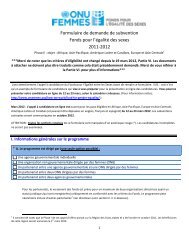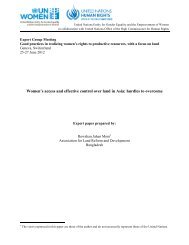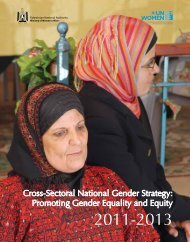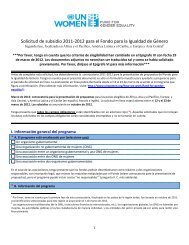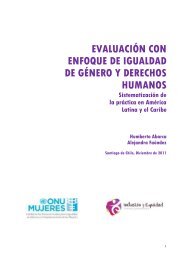Informal Justice Systems: Charting a Course for Human - UN Women
Informal Justice Systems: Charting a Course for Human - UN Women
Informal Justice Systems: Charting a Course for Human - UN Women
Create successful ePaper yourself
Turn your PDF publications into a flip-book with our unique Google optimized e-Paper software.
sUMMarY<br />
8<br />
in structure, this summary of the study, first describes ijs across the range of degrees of <strong>for</strong>mality and in<strong>for</strong>mality<br />
and interaction with the state. it identifies the combination of factors that influence individuals’ or communities’<br />
preferences and pressures to bring matters be<strong>for</strong>e ijs rather than be<strong>for</strong>e <strong>for</strong>mal justice systems. these factors influencing<br />
preferences <strong>for</strong> ijs vary from geographical isolation, economic concerns, familiarity, trust and the perception<br />
that ijs better reflect local values. it then places ijs in the context of human rights, with particular attention<br />
to the rights of women and children. finally, it frames the principles of programming engagement with ijs and<br />
suggests possible entry points <strong>for</strong> engagement with ijs, so that strategic engagement can strengthen ijs to better<br />
deliver justice and human rights.<br />
methodoLogy<br />
commissioned by unDP, unicef and un <strong>Women</strong>, the study involved a comprehensive literature review and<br />
country-specific case studies. Qualitative and quantitative data collection was carried out in Bangladesh, ecuador,<br />
malawi, niger, Papua new guinea and uganda. the country studies were selected in consultation with the<br />
three un agencies and the methodology was developed through a pilot case study in malawi. the country studies<br />
employed a uni<strong>for</strong>m methodology, and all of the country studies use identical or very similar categories of<br />
analysis. interviews were conducted with individuals and groups representing various stakeholders at the local<br />
and national levels on the basis of an interview guide developed <strong>for</strong> each of the target categories. the quantitative<br />
part of the country studies included surveys <strong>for</strong> users of in<strong>for</strong>mal justice and in<strong>for</strong>mal justice providers, following a<br />
generic questionnaire <strong>for</strong>mat that allowed comparison across countries.<br />
Desk studies of 12 countries were also conducted on the basis of literature from academia, un agencies, ngos,<br />
governments, websites and conferences. Wherever possible, they were developed in consultation with national<br />
experts on the in<strong>for</strong>mal and the <strong>for</strong>mal justice systems, including scholars and human rights experts. the desk<br />
studies assessed the nature and characteristics of ijs (composition, decision-making, procedures), linkages among<br />
the different justice providers (particularly with <strong>for</strong>mal justice systems), legal frameworks, human rights aspects<br />
and ef<strong>for</strong>ts made to date in programming by governments, national and international ngos, the un and other<br />
development partners.<br />
definitions of in<strong>for</strong>maL <strong>Justice</strong> systems<br />
any attempt to define ijs must acknowledge that no definition can be both very precise and sufficiently broad to<br />
encompass the range of systems and mechanisms that play a role in delivering rule of law and access to justice.<br />
ijs vary considerably, encompassing many mechanisms of differing degrees and <strong>for</strong>ms of <strong>for</strong>mality. Degrees of<br />
<strong>for</strong>mality vary with respect to legal or normative framework, state recognition, appointment and interaction,<br />
control and accountability mechanisms, and systems of monitoring and supervision, including the maintenance<br />
of case records and the implementation of referral procedures. ijs also encompass systems that might have <strong>for</strong>mal<br />
state recognition, such as alternative dispute resolution that operate at the community level, either facilitated by<br />
traditional mechanisms or facilitated by ngos.<br />
the study employs a relatively broad definition of ‘in<strong>for</strong>mal justice system’ encompassing the resolution of disputes<br />
and the regulation of conduct by adjudication or the assistance of a neutral third party that is not a part of the judiciary<br />
as established by law and/or whose substantive, procedural or structural foundation is not primarily based<br />
on statutory law.<br />
in some settings, the word ‘in<strong>for</strong>mal’ may carry value-laden assessments, according to which a system may be<br />
held in lower esteem because of the ‘in<strong>for</strong>mal’ label. the study uses the word with no such value judgments. it<br />
is used rather than the term ‘non-state’ justice systems, as there are many <strong>for</strong>ms of ijs that are tolerated, partially<br />
a stuDy of in<strong>for</strong>mal justice systems: access to justice anD human rights



